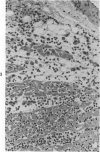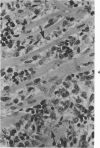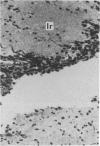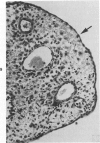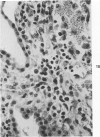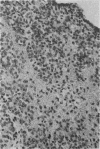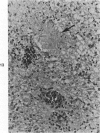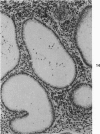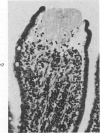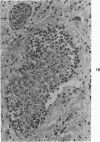Abstract
Inoculation of dogs with Trypanosoma brucei produced an acute fetal disease similar to that seen following natural infection. The disease was characterised by high levels of parasitaemia, moderately severe anemia, and marked changes in the lymphoid system. Extravascular invasion by large numbers of trypanosomes was widespread throughout the body and was accompanied by severe tissue damage. Tissue invasion by trypanosomes was associated with marked cellular infiltration involving lymphoid cells and plasma cells followed by macrophages and polymorphonuclear leukocytes. Associated with these reactions, severe cellular degeneration and focal necrosis occurred. While these changes were widespread and were found in the majority of tissues examined, consistently severe lesions were found in the heart, eyes and central nervous system. In many organs, lymphatic vessels were distended with fluid, trypanosomes, and a cell population similar to that in the surrounding tissue; fibrin deposition and thrombus formation was sometimes observed within the lymphatic lumens. Thrombosis was also found in the blood vessels of the pampiniform plexus, the venous plexus of the ovary, and branches of the renal vein. A severe necrotizing vasculitis affecting only the coronary vessels was a prominent feature in some animals.
Full text
PDF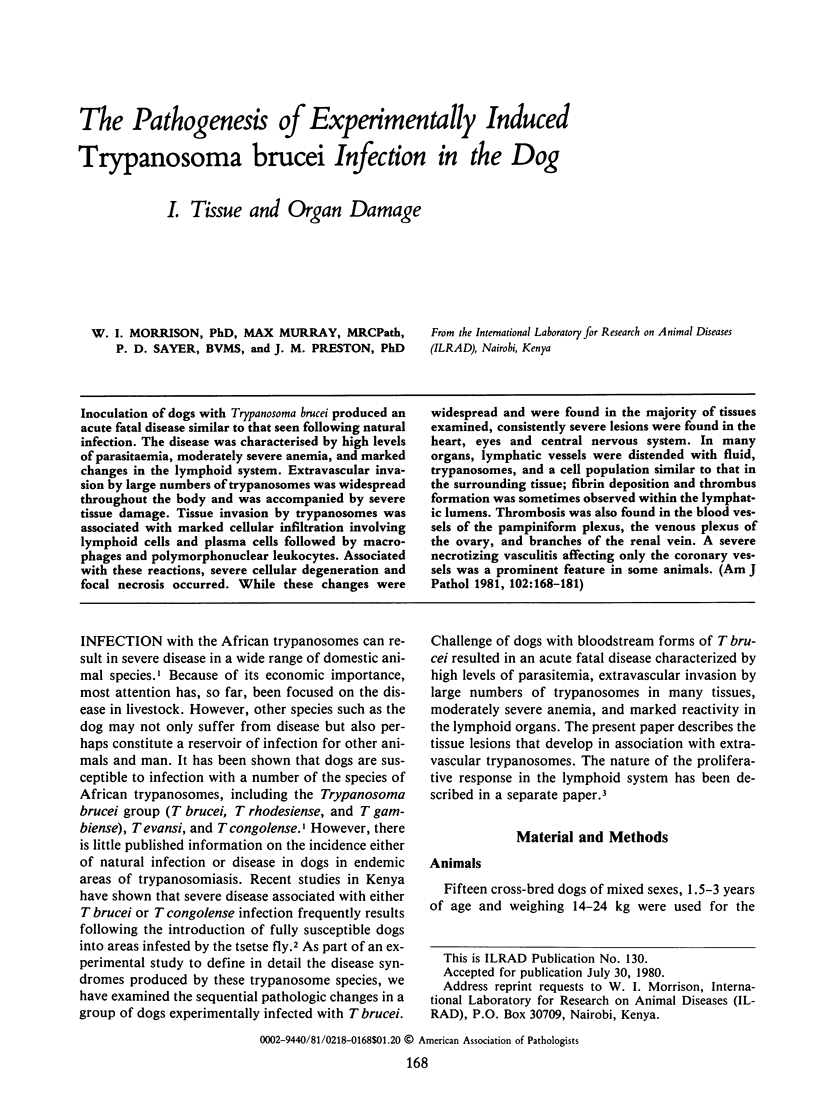
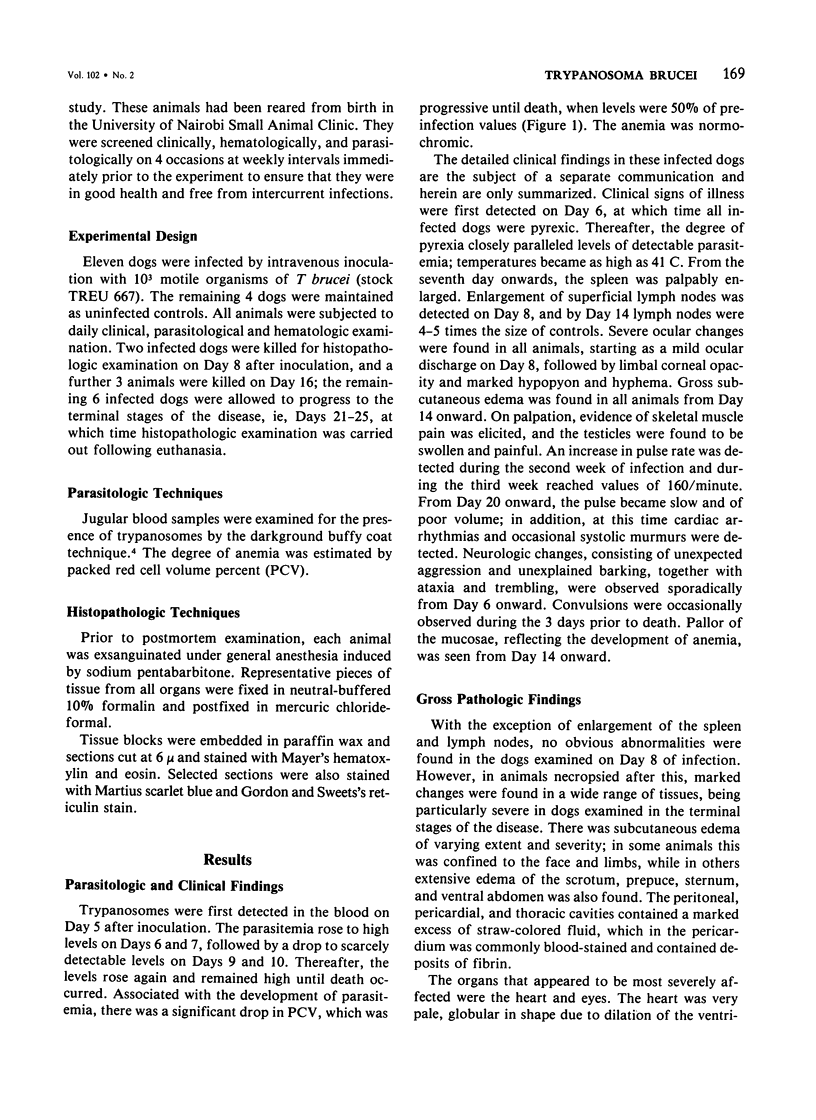
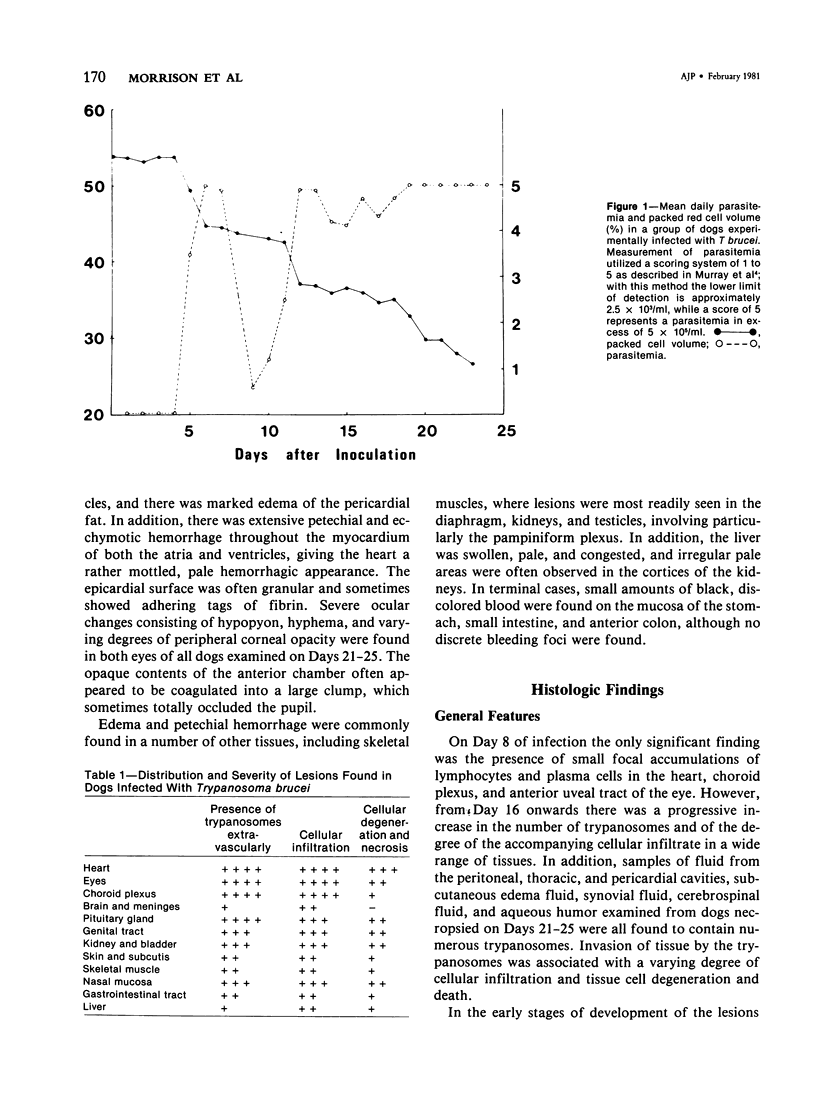

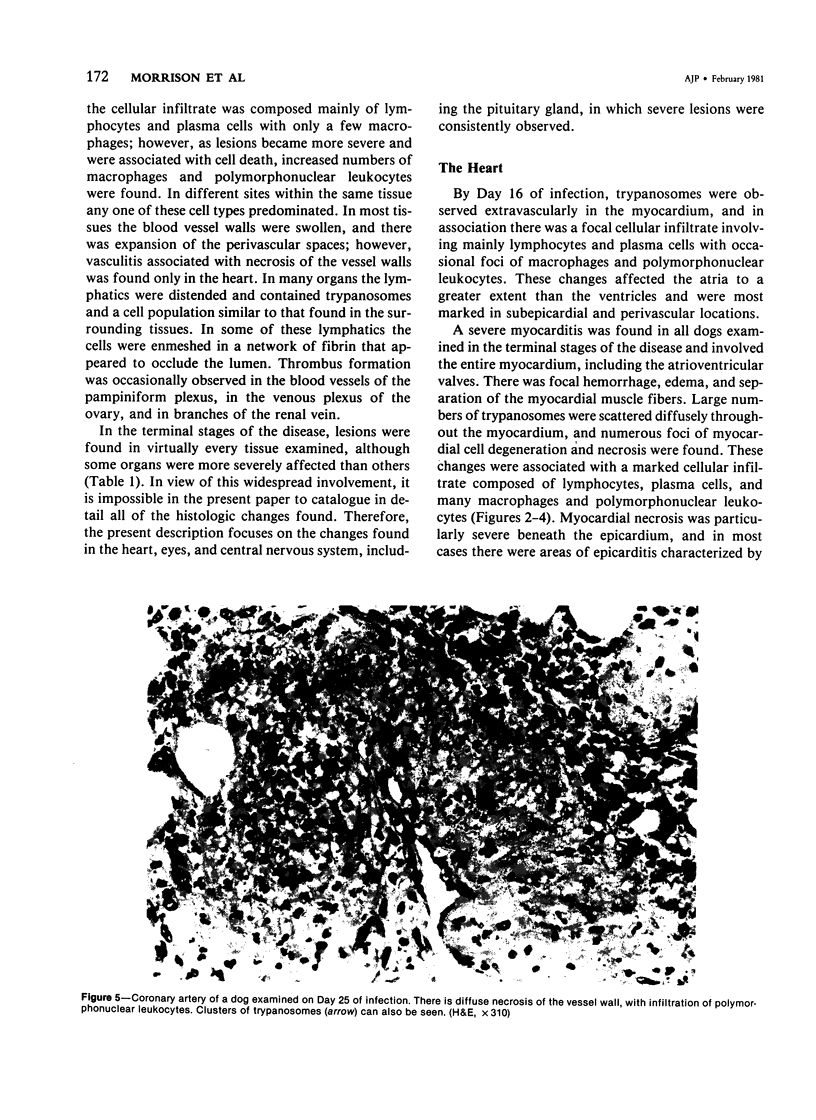
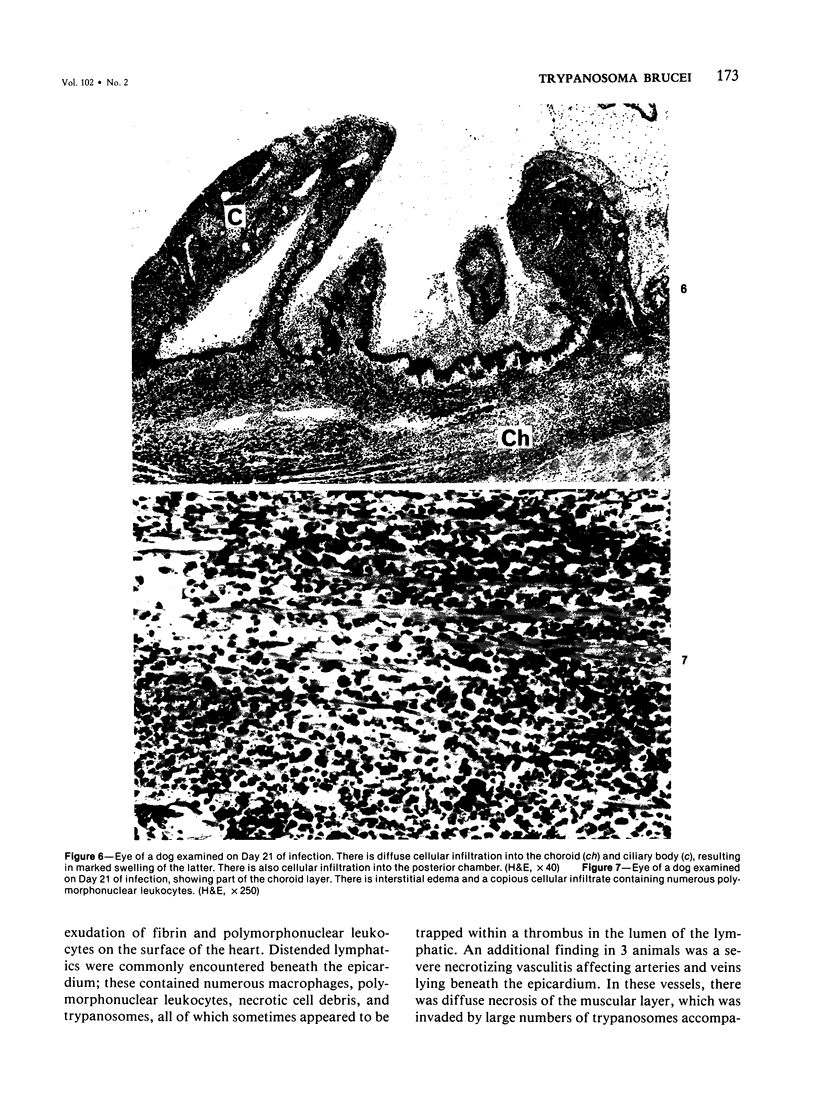
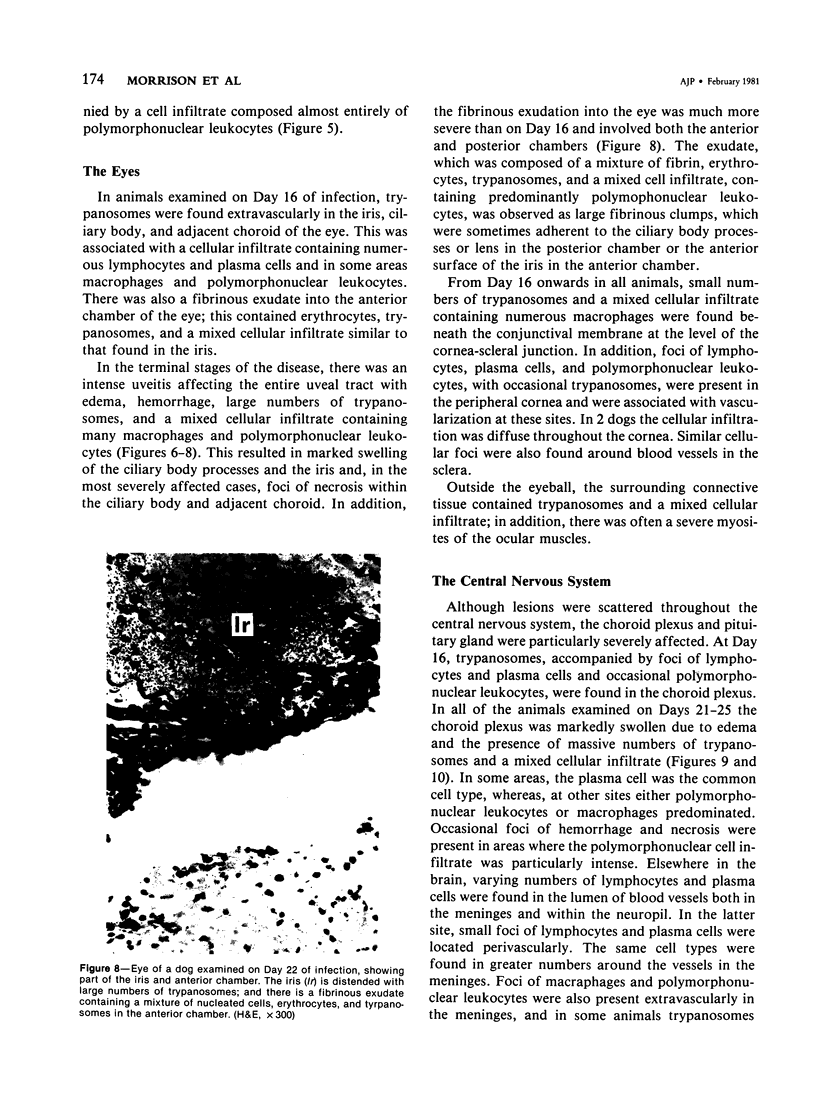
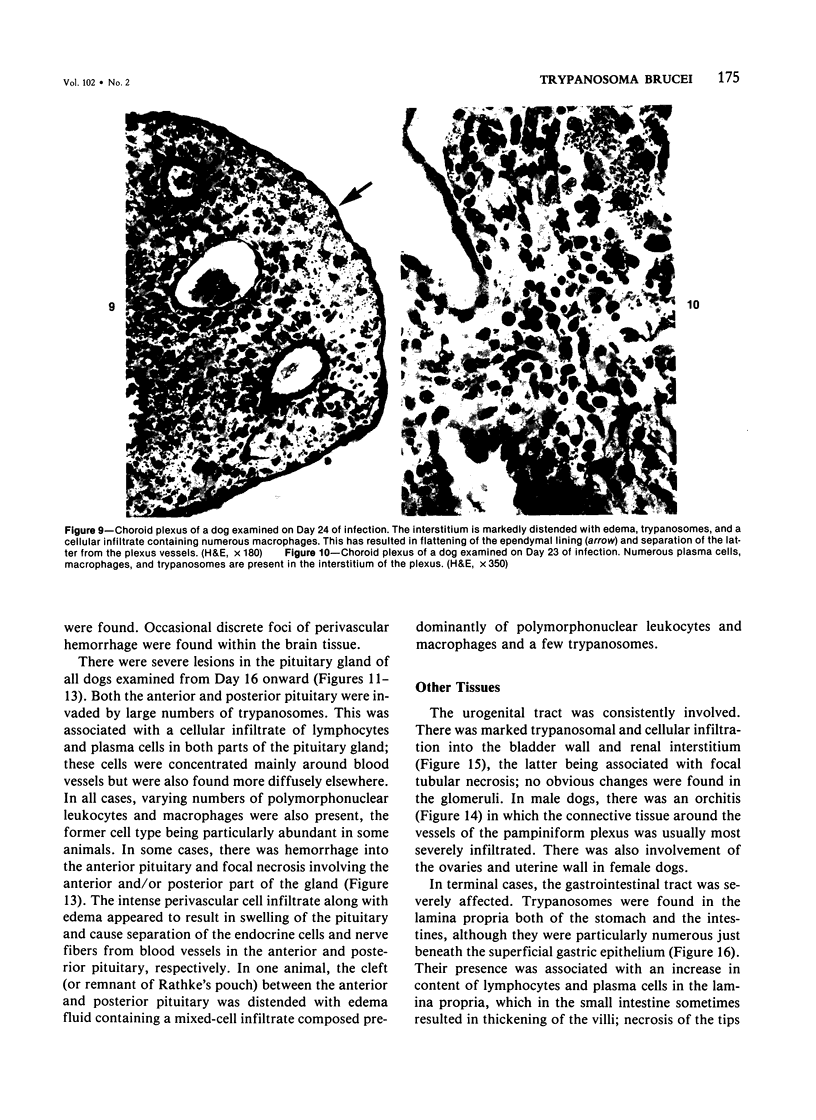
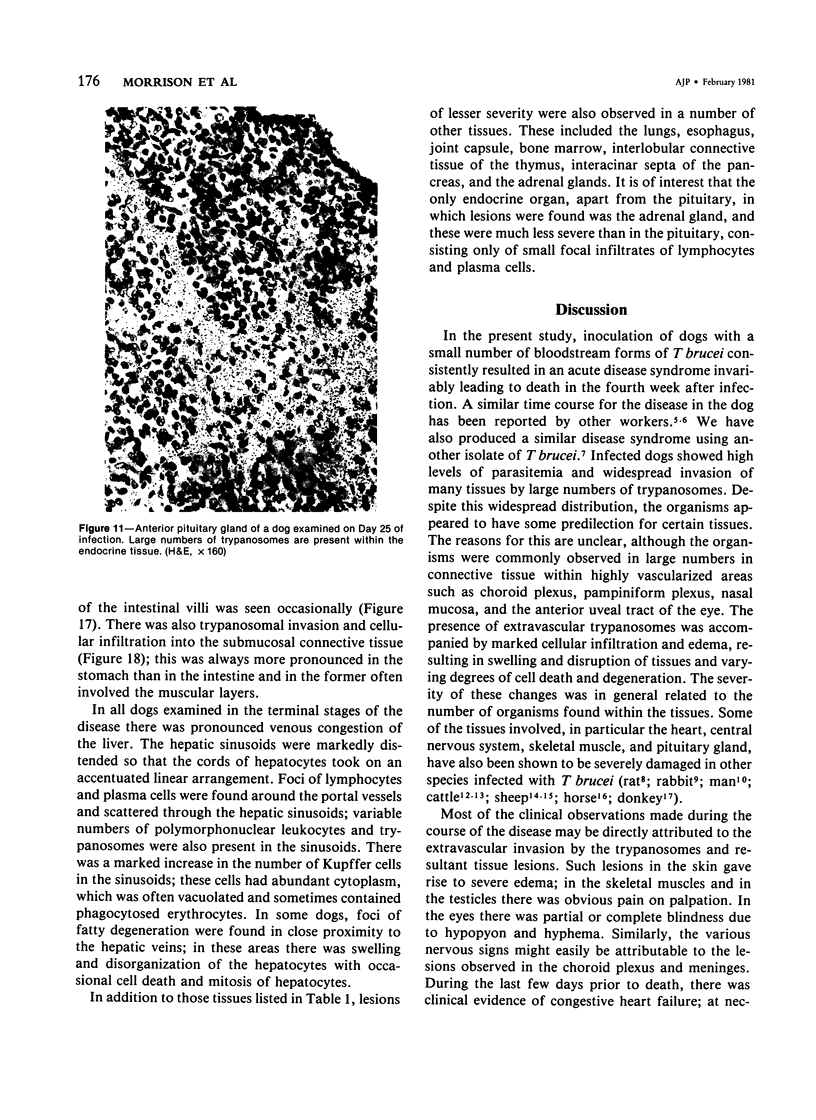
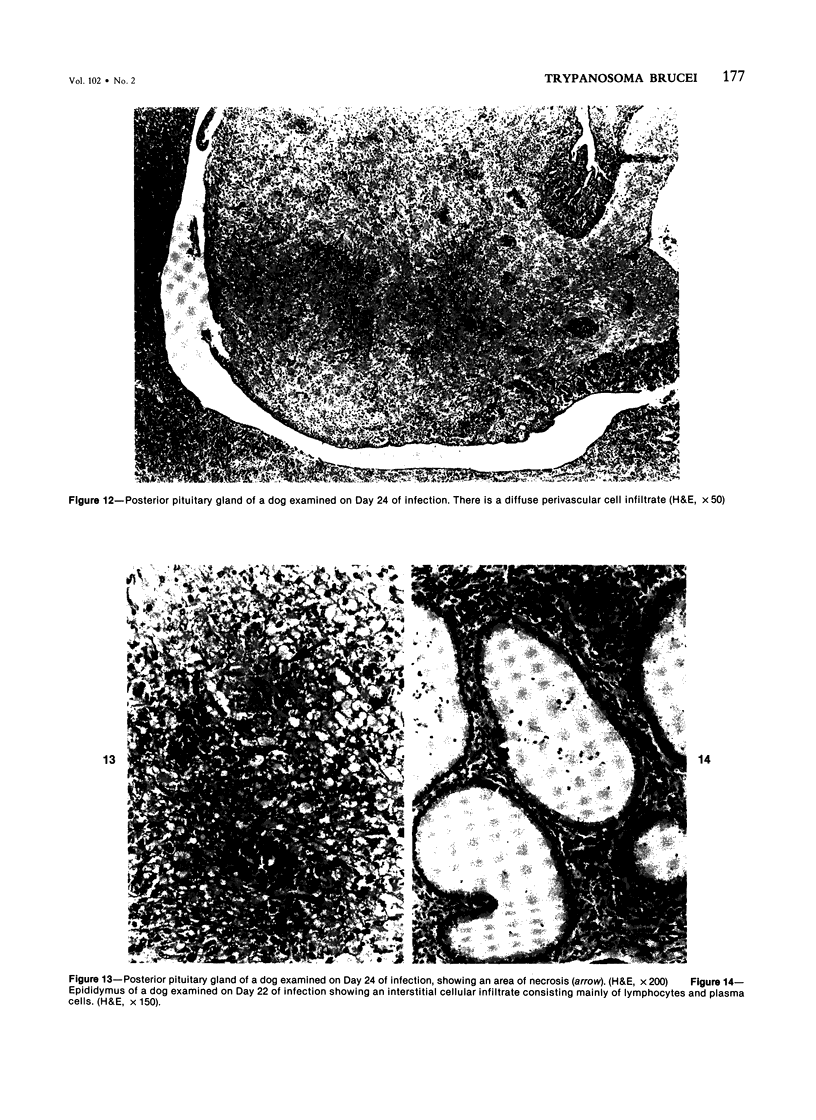

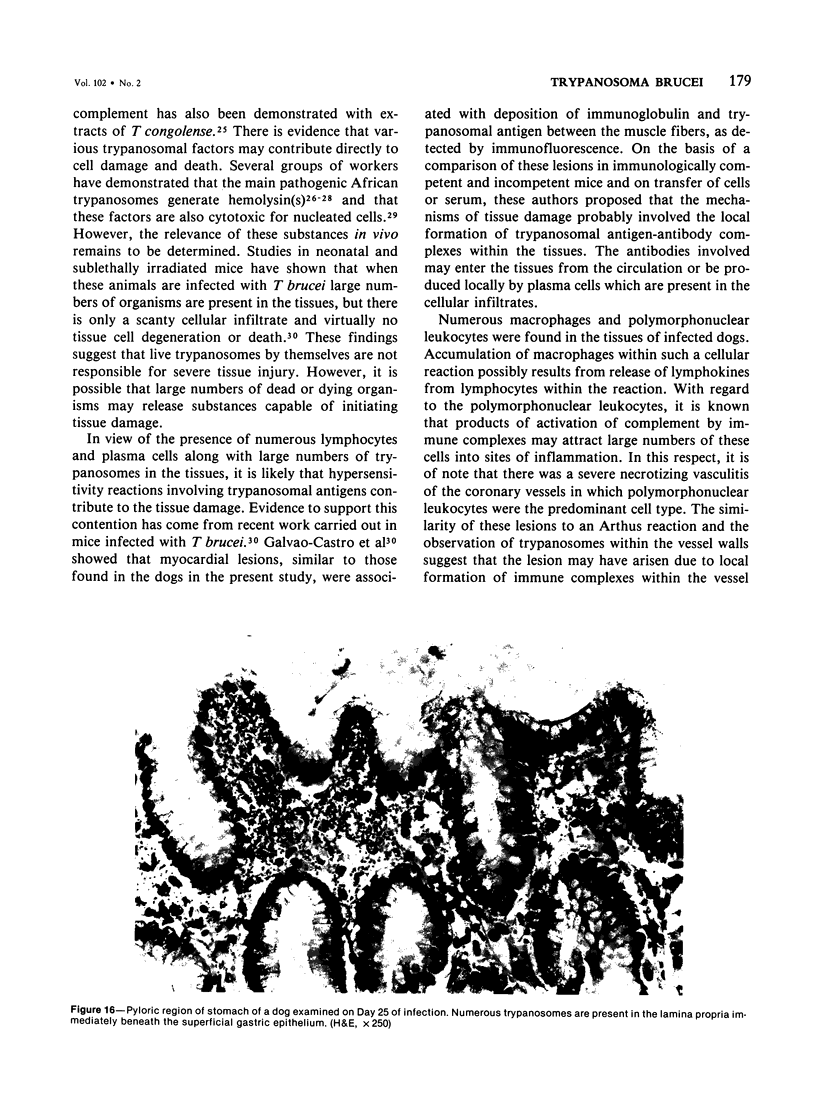
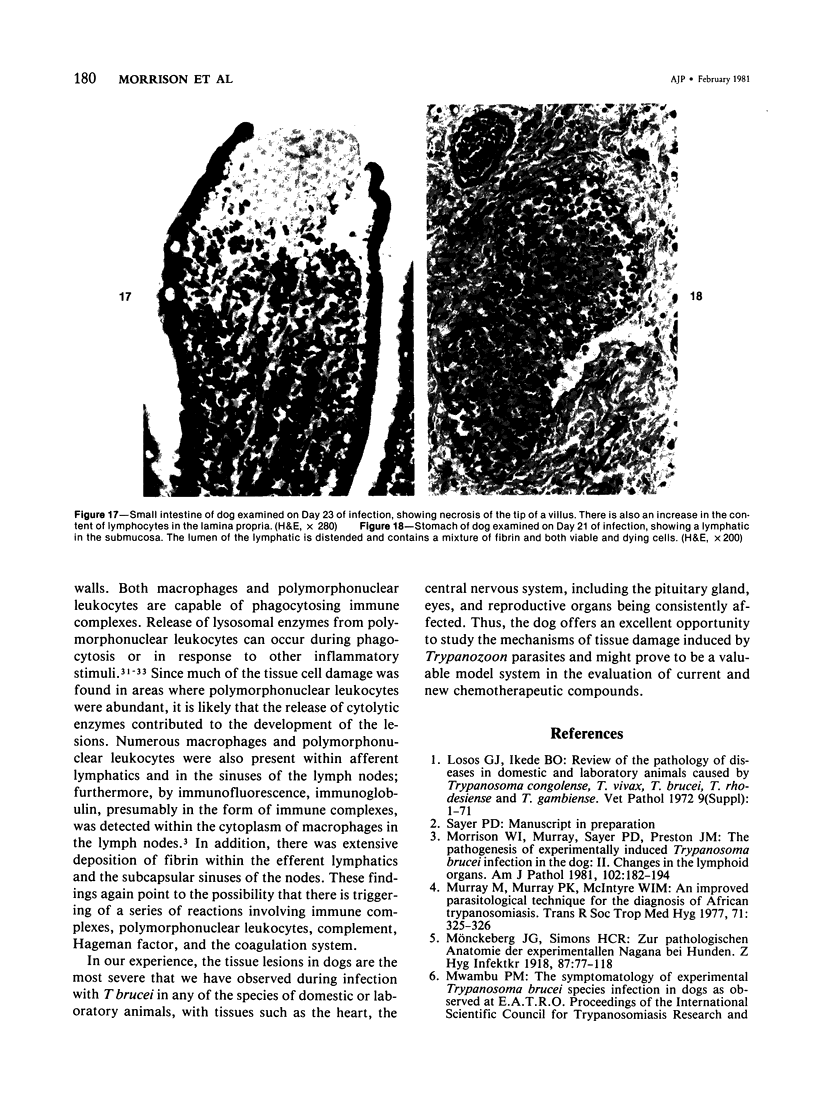
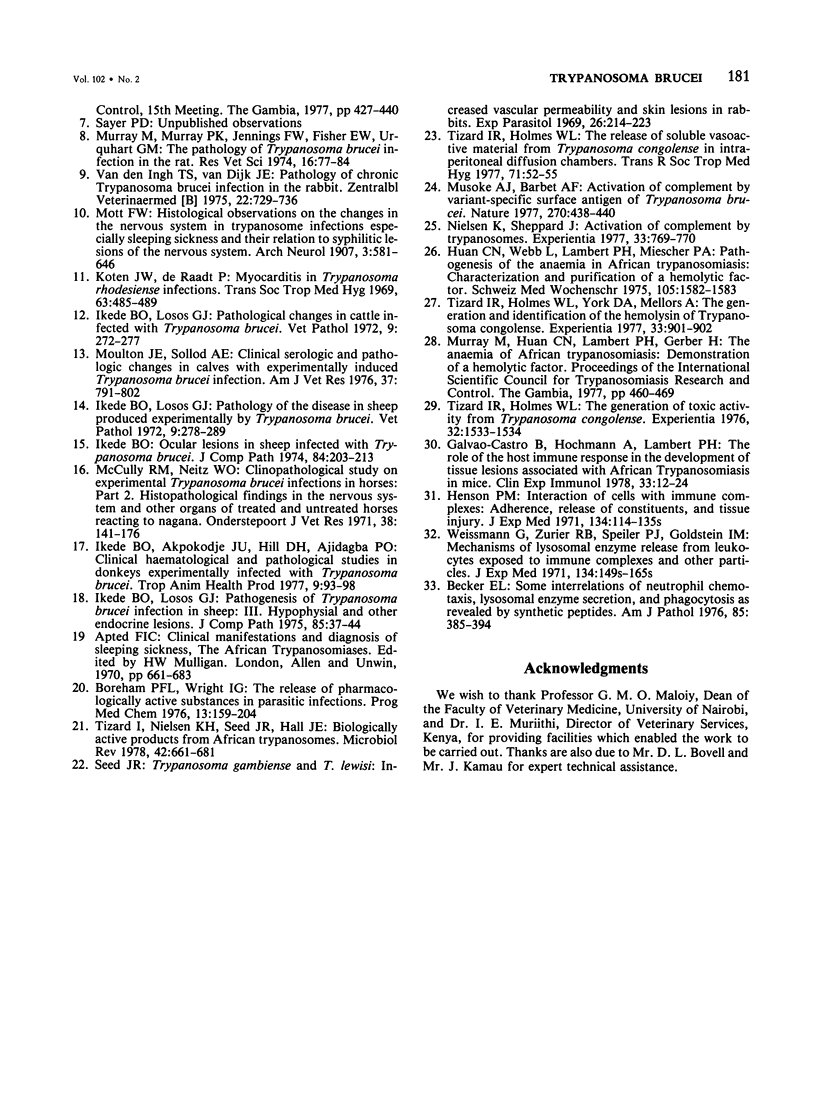
Images in this article
Selected References
These references are in PubMed. This may not be the complete list of references from this article.
- Becker E. L. Some interrelations of neutrophil chemotaxis, lysosomal enzyme secretion, and phagocytosis as revealed by synthetic peptides. Am J Pathol. 1976 Nov;85(2):385–394. [PMC free article] [PubMed] [Google Scholar]
- Boreham P. F., Wright I. G. The release of pharmacologically active substances in parasitic infections. Prog Med Chem. 1976;13:159–204. doi: 10.1016/s0079-6468(08)70138-3. [DOI] [PubMed] [Google Scholar]
- Galvao-Castro B., Hochmann A., Lambert P. H. The role of the host immune response in the development of tissue lesions associated with African trypanosomiasis in mice. Clin Exp Immunol. 1978 Jul;33(1):12–24. [PMC free article] [PubMed] [Google Scholar]
- Henson P. M. Interaction of cells with immune complexes: adherence, release of constituents, and tissue injury. J Exp Med. 1971 Sep 1;134(3 Pt 2):114s–135s. [PubMed] [Google Scholar]
- Huan C. N., Webb L., Lambert P. H., Miescher P. A. Pathogenesis of the anemia in african trypanosomiasis: characterization and purification of a hemolytic factor. Schweiz Med Wochenschr. 1975 Nov 22;105(47):1582–1583. [PubMed] [Google Scholar]
- Ikede B. O., Akpokodje J. U., Hill D. H., Ajidagba P. O. Clinical, haematological and pathological studies in donkeys experimentally infected with Trypanosoma brucei. Trop Anim Health Prod. 1977 May;9(2):93–98. doi: 10.1007/BF02236387. [DOI] [PubMed] [Google Scholar]
- Ikede B. O., Losos G. J. Pathogenesis of Trypanosoma brucei infection in sheep. III. Hypophysial and other endocrine lesions. J Comp Pathol. 1975 Jan;85(1):37–44. doi: 10.1016/0021-9975(75)90082-1. [DOI] [PubMed] [Google Scholar]
- Ikede B. O., Losos G. J. Pathological changes in cattle infected with Trypanosoma brucei. Vet Pathol. 1972;9(4):272–277. doi: 10.1177/030098587200900407. [DOI] [PubMed] [Google Scholar]
- Ikede B. O., Losos G. J. Pathology of the disease in sheep produced experimentally by Trypanosoma brucei. Vet Pathol. 1972;9(4):278–289. doi: 10.1177/030098587200900408. [DOI] [PubMed] [Google Scholar]
- Ikede B. O. Ocular lesions in sheep infected with Trypanosoma brucei. J Comp Pathol. 1974 Apr;84(2):203–213. doi: 10.1016/0021-9975(74)90061-9. [DOI] [PubMed] [Google Scholar]
- Koten J. W., De Raadt P. Myocarditis in Trypanosoma rhodesiense infections. Trans R Soc Trop Med Hyg. 1969;63(4):485–489. doi: 10.1016/0035-9203(69)90036-4. [DOI] [PubMed] [Google Scholar]
- McCully R. M., Neitz W. O. Clinicopathological study on experimental Trypanosma brucei infections in horses. 2. Histopathological findings in the nervous system and other organs of treated and untreated horses reacting to nagana. Onderstepoort J Vet Res. 1971 Sep;38(3):141–175. [PubMed] [Google Scholar]
- Morrison W. I., Murray M., Sayer P. D., Preston J. M. The pathogenesis of experimentally induced Trypanosoma brucei infection in the dog. II. Change in the lymphoid organs. Am J Pathol. 1981 Feb;102(2):182–194. [PMC free article] [PubMed] [Google Scholar]
- Moulton J. E., Sollod A. E. Clinical, serologic, and pathologic changes in calves with experimentally induced Trypanosoma brucei infection. Am J Vet Res. 1976 Jul;37(7):791–802. [PubMed] [Google Scholar]
- Murray M., Murray P. K., Jennings F. W., Fisher E. W., Urquhart G. M. The pathology of Trypanosoma brucei infection in the rat. Res Vet Sci. 1974 Jan;16(1):77–84. [PubMed] [Google Scholar]
- Murray M., Murray P. K., McIntyre W. I. An improved parasitological technique for the diagnosis of African trypanosomiasis. Trans R Soc Trop Med Hyg. 1977;71(4):325–326. doi: 10.1016/0035-9203(77)90110-9. [DOI] [PubMed] [Google Scholar]
- Musoke A. J., Barbet A. F. Activation of complement by variant-specific surface antigen of trypanosoma brucei. Nature. 1977 Dec 1;270(5636):438–440. doi: 10.1038/270438a0. [DOI] [PubMed] [Google Scholar]
- Nielsen K., Sheppard J. Activation of complement by trypanosomes. Experientia. 1977 Jun 15;33(6):769–771. doi: 10.1007/BF01944182. [DOI] [PubMed] [Google Scholar]
- Seed J. R. Trypanosoma gambiense and T. lewisi: increased vascular permeability and skin lesions in rabbits. Exp Parasitol. 1969 Oct;26(2):214–223. doi: 10.1016/0014-4894(69)90115-5. [DOI] [PubMed] [Google Scholar]
- Tizard I. R., Holmes W. L. The generation of toxic activity from trypanosoma congolense. Experientia. 1976 Dec 15;32(12):1533–1534. doi: 10.1007/BF01924436. [DOI] [PubMed] [Google Scholar]
- Tizard I. R., Holmes W. L. The release of soluble vasoactive material from Trypanosoma congolense in intraperitoneal diffusion chambers. Trans R Soc Trop Med Hyg. 1977;71(1):52–55. doi: 10.1016/0035-9203(77)90208-5. [DOI] [PubMed] [Google Scholar]
- Tizard I. R., Holmes W. L., York D. A., Mellors A. The generation and identification of the hemolysin of Trypanosoma congolense. Experientia. 1977 Jul 15;33(7):901–902. doi: 10.1007/BF01951271. [DOI] [PubMed] [Google Scholar]
- Tizard I., Nielsen K. H., Seed J. R., Hall J. E. Biologically active products from African Trypanosomes. Microbiol Rev. 1978 Dec;42(4):664–681. doi: 10.1128/mr.42.4.664-681.1978. [DOI] [PMC free article] [PubMed] [Google Scholar]
- Weissmann G., Zurier R. B., Spieler P. J., Goldstein I. M. Mechanisms of lysosomal enzyme release from leukocytes exposed to immune complexes and other particles. J Exp Med. 1971 Sep 1;134(3 Pt 2):149s–165s. [PubMed] [Google Scholar]
- van den Ingh T. S., van Dijk J. E. Pathology of chronic Trypanosoma bruceï-infection in the rabbit. Zentralbl Veterinarmed B. 1975 Nov;22(9):729–736. doi: 10.1111/j.1439-0450.1975.tb00639.x. [DOI] [PubMed] [Google Scholar]




